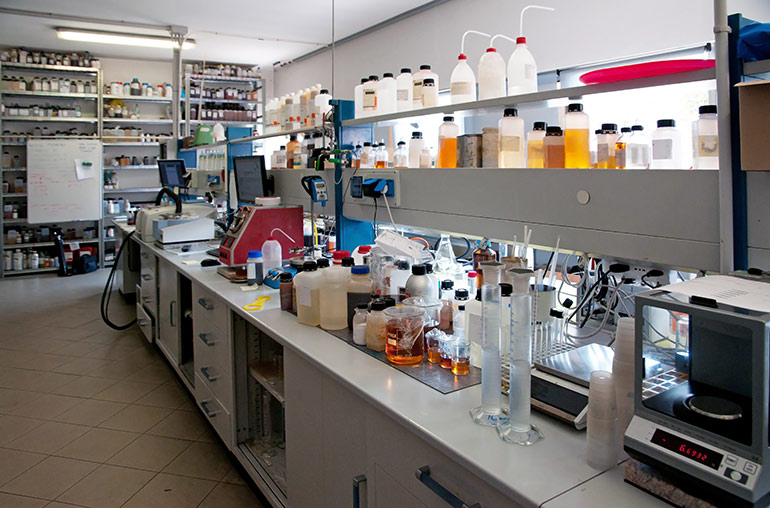By Josh Cosford, Contributing Editor
As the last article in the series on laboratory-based hydraulic oil analyses, we thought we’d provide a single article to recap the tests in one convenient location. For the past six months we’ve discussed just as many topics important to your predictive maintenance program. Each one of these parameters is tested by your local oil analysis lab from a sample collected from one or more of your power units.

Viscosity – The quality described as oil’s resistance to flow, or generally speaking, how thick or thin it is. Knowing the measured viscosity of your oil is vital to understanding the potential pitfalls of oil falling outside the ideal range optimal for your machine. Thick oil leads to wasted energy, cavitation and poor lubrication, while thin oil results in excessive leakage, rapid wear and overheating.
Your lab will first heat the oil to 40°C (104°F) and then run it through a kinematic viscosity test to confirm or deny it matches specifications. They can then rerun the test at 100°C (212°C) to calculate the viscosity index, which is a measure of hydraulic oil’s tendency to maintain its viscosity over a wide temperature range.
Particles – The bits of contamination inside your hydraulic system that scratch, score and wear important and necessary internal components. They wear pistons, gears, vanes, spools, bodies and sealing surfaces, making particle contamination one of the most important criteria you want your lab to measure for you.
Using sophisticated equipment, the lab will provide a report showing the number of 4, 6 and 16 micron particles in a single milliliter of fluid, and expressed as a range. For example, a result with 18/15/13 on your report tells you you’re dealing with 1300-2500 4µm particles, 160-320 6µm particles and 40-60 14µm particles. Less is always better, and your oil can never be too clean.
Water – Water is also a form of contamination and will cause catastrophic failure more quickly than particles when present in excessive amounts. Lubricity is reduced, oxidation increases and increased cavitation likelihood. It can also be tough to remove, so it’s important to monitor its presence so you can provide corrective action if needed.
The lab will provide you with a result in Parts Per Million (ppm), and just like particles, less is better. 500 ppm is a red flag, and you should consider both how the water is ingested and your options for removing it. You won’t go wrong aiming for 200 ppm, but if you have so much water that your oil is cloudy, act immediately to remove the water or replace your oil.
Acidity – The Total Acid Number is a representation of the amount of acidic compounds in your oil. Excessive acidity leads to corrosion, increased wear and damage to internal components. Acidity comes as a result of oxidation, contamination and sometimes the degradation of oil additives.
The lab will provide you with a report showing how many milligrams of potassium hydroxide (KOH) are needed to neutralize the acid in one gram of sample oil. Expressed as KOH/g, you will hope to find less than 1.0 on your report but know that unless there is a dramatic increase in contamination, this health marker is one that trends over a long period.
Spectrometry – This sophisticated test provides you with a detailed breakdown of the elemental composition of the contamination within the oil. The result provides you insight into the health of your hydraulic systems and pumps, valves and actuators within. Excessive iron, bronze, zinc and nickel within your oil can point you towards wear or imminent failure of the parent component containing that element.
A test such as the ASTM D5185, which looks for 22 different elements within your hydraulic fluid, will uncover almost anything within your hydraulic system. Each element will be expressed in parts per million, and the absolute number, unless extreme, isn’t always as important as the trend. Some elements, such as zinc, are additives that help reduce wear between metal components. Your job is to research what you should have little of and what you should have a lot of.
Additives – This is where things get blurry because additives are partially measured by spectrometry. However, the test can be combined with elemental analysis to look for particular compounds specific to the oil itself rather than the internal components of the system. Zinc, molybdenum, rust inhibitors, antioxidants, detergents and viscosity index improvers are all important additives that provide benefits to the oil outside of just a lubricating pressure medium.
Hydraulic oil is expensive to replace, so if you can replace or fine-tune the additive package, your oil will last indefinitely so long as the above tests encourage you to adhere to a well-formulated maintenance program. If you’re not already implementing an oil analysis program, reach out to your local fluid power shop to see how they can help.
Filed Under: Components Oil Coolers, Contamination Control, Engineering Basics, Filtration, Fluid Conditioning, Fluids, Sealing & Contamination Control Tips